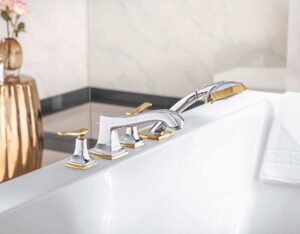Choosing the right thermostatic bath shower mixer supplier can be a daunting task for procurement officers. The wrong choice can lead to project delays, poor quality control, and dissatisfied clients. This article outlines key factors to consider to ensure long-term success and reliable partnerships.
Ensure you choose a thermostatic bath shower mixer supplier with a strong reputation for quality and reliability, a wide range of product offerings, excellent customer support, and adherence to industry standards and certifications.
Let’s dive deeper into what you should look for in a supplier.
What to Look for When Buying a Shower Mixer?
When you’re on the hunt for a shower mixer, it’s key to consider the water flow and pressure. Make sure the mixer matches up with your water system, whether it’s gravity-fed, a pressure system, or a combi boiler. The right mixer will give you top-notch performance and a satisfying shower every time. So, get to know your plumbing system’s ins and outs and find a mixer that fits like a glove. For instance, if you’ve got a low-pressure system, look for a mixer designed to work efficiently with it to keep that water flow steady and strong. Also, check the water pressure from both your hot and cold supplies to make sure they’re balanced. An unbalanced supply can mess with the temperature and make your shower less enjoyable. And don’t forget about your showerhead – different heads can affect the flow rate and pressure too.
What Are Common Problems with Thermostatic Shower Valves?
Thermostatic shower valves can run into issues like misaligned components, rusted or corroded parts, and mineral build-up. These problems can mess with the valve’s performance and lifespan. Keeping up with regular maintenance and choosing a high-quality supplier can keep these headaches at bay. Misaligned parts usually happen during installation and can lead to funky hot and cold water mixing, causing temperature swings. Rust and corrosion, especially in areas with hard water, can break down the valve over time, messing with its ability to regulate temperature accurately. Mineral build-up, like limescale, can clog the valve and reduce water flow. To dodge these problems, regularly check and clean the valve. Using water softeners can help cut down on mineral deposits. Also, picking valves made from rust-resistant materials, like stainless steel or brass, can extend their life and keep them running smoothly.
How Long Do Thermostatic Shower Valves Last?
Thermostatic shower valves usually last between 5 to 10 years. But their lifespan can depend on how you use them, the quality of your water, and how well you maintain them. Heavy use, poor water quality, or skipping maintenance can cut their life short. Regular cleaning and replacing parts on time can help them last longer. Follow the manufacturer’s maintenance tips to keep the valve in top shape. Check the valve now and then for signs of wear, like leaks or reduced water flow, to catch issues early. Swapping out worn seals and gaskets can prevent leaks and keep water pressure up. Flushing the system to clear out debris or mineral build-up can also boost efficiency. Going with a high-quality valve from a reputable supplier can give you a product that’s built to handle daily use and tough water conditions.
What Are the Disadvantages of a Thermostatic Shower?
Thermostatic showers have a lot going for them, but they’ve got some downsides too. The biggest con is the price – these valves usually cost more than pressure-balance valves. Plus, the trim that comes with thermostatic valves often has two handles, which might not fit everyone’s style. The higher initial cost can put some people off, especially if they’re on a tight budget. But this cost is often worth it for the extra safety and comfort thermostatic valves provide. Another downside is the tricky installation. Thermostatic valves need precise alignment and calibration to work right, which can add to installation time and cost. In older homes, you might need to upgrade your plumbing to fit a thermostatic valve, adding more expense. And while they’re pretty low-maintenance, they do need regular check-ups to avoid issues like mineral build-up, which can be a hassle if you’re looking for something you can just set and forget.
Pros and Cons of Thermostatic Showers
Thermostatic showers are great for keeping the water temperature steady and making sure you don’t get scalded or frozen out mid-shower. But their higher price tag and specific design needs can be a turn-off. On the plus side, they keep the water temperature constant even when someone else is using water elsewhere in the house, which is a big win for comfort and safety. This is especially handy for families with kids or elderly folks who are more sensitive to temperature changes. You can also preset the temperature, so you don’t have to mess with it every time you shower. On the downside, the higher initial cost and the more complicated installation can be big drawbacks. Plus, the design of thermostatic valves, with separate controls for temperature and flow, might not be everyone’s cup of tea, especially if you prefer a simpler look. Despite these downsides, the benefits of better safety and comfort often outweigh the cons for many people.
Does a Thermostatic Shower Need Electricity?
A lot of people think thermostatic showers need electricity, but that’s not the case. They use temperature-sensitive elements to control the mix of hot and cold water, keeping the temperature steady without needing electrical power. This makes them a flexible option you can install just about anywhere without having to deal with extra wiring. The temperature-sensitive elements, usually made of wax or bimetallic strips, expand or contract with temperature changes, adjusting the flow of hot and cold water to keep things steady. This passive system not only keeps the temperature just right but also makes the valve more reliable and long-lasting. Some modern thermostatic showers do have extra features like digital displays or remote controls that need electricity, but the basic function of the valve doesn’t require power. These extras can add some convenience, but they’re not necessary for the valve to do its main job.
How Does a Thermostatic Bath Shower Mixer Work?
Thermostatic bath shower mixers blend hot and cold water to a preset temperature. They use a thermostatic element to sense temperature changes and adjust the mix accordingly, giving you a consistent and safe shower. This tech makes sure sudden changes in water pressure or temperature won’t mess with your shower. The thermostatic element, often made of wax or bimetallic strips, reacts quickly to temperature changes, expanding or contracting to adjust the flow of hot and cold water. This quick response keeps the water temperature steady, even if someone else in the house uses a tap or flushes the toilet. Many thermostatic mixers also have safety features, like an automatic shut-off if the cold water supply fails, to prevent scalding. Knowing how this works helps you appreciate the precision and safety that thermostatic mixers offer, making them a top choice for many homeowners and businesses.
Summary
Choosing the right thermostatic bath shower mixer supplier involves evaluating their reputation for quality, the range of products offered, customer support, and adherence to industry standards. By carefully considering these factors, you can ensure long-term success and reliable partnerships in your projects.




